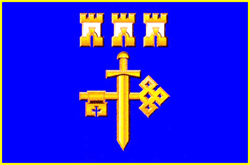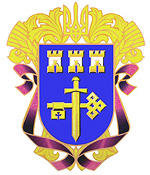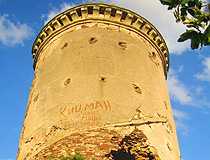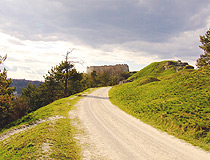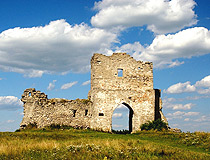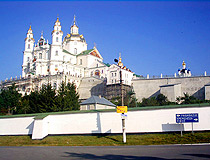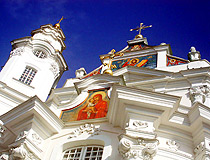Ternopil Oblast - Overview
Ternopil Oblast or Ternopilska Oblast is an administrative region located in the west of Ukraine with the center in the city of Ternopil. In historical and ethnographic terms, this region occupies the territory of the eastern part of Galicia, the western part of Podolia and the southern part of Volyn.
The population of Ternopil Oblast (2021) is about 1,022,000 (2.48% of the total population of Ukraine).
The area of Ternopil Oblast is 13,824 sq. km. (2.3% of the total area of Ukraine).
History of Ternopil Oblast
In the 9th century, East Slavic lands united in a loose federation known as Kievan Rus. On the territory of the Ternopil region, remains of more than 300 settlements of the 10th-13th centuries have been discovered. In 988, Vladimir the Great introduced the state religion in Kievan Rus - Christianity. At the same time, the lands of White Croats - the territory of present Galicia and the Carpathian region including the current Ternopil region - became part of Kievan Rus.
In the 12th century, Kievan Rus was swept by numerous wars between the princes, one of the major battles took place near Terebovlya in February 1154. Later, the territory of the Ternopil region joined the Galicia-Volhynia Principality. The towns of Terebovlya and Shumsk turned into significant political, economic and cultural centers. During the Mongol invasion, most of the towns of the region were destroyed.
In 1349, after the Galicia-Volhynia Principality ceased to exist, the struggle began between the Grand Duchy of Lithuania, the Kingdom of Poland and the Hungarian Kingdom for this territory. After the Union of Lublin of 1569, the entire territory of the present Ternopil region was ruled by The Polish-Lithuanian Commonwealth.
By the end of the 15th century, the Turkish raids on Podolia began, the raids of the Tatars of the Crimean Khanate became more frequent. In the 17th century, when Poland could no longer restrain the devastating attacks of the Tatars, the raids situation deteriorated. Over the 15th-17th centuries, the Ternopil region experienced more than 200 major raids.
More historical facts…
Polish national, social and religious oppression caused widespread discontent of the local population, which ultimately resulted in uprisings. The most famous one was the uprising lead by the Kozak ataman Nalyvayko from the town of Husyatyn in 1594-1596. During the Cossack-Polish War (1648-1657) under the leadership of Bohdan Khmelnytsky, the Zbarazh siege and the Zboriv battle took place in this region. The Zboriv Treaty (1649) gave the beginning of a relatively independent Ukrainian state - The Cossack Hetmanate. However, the territory of the present Ternopil region was not part of it.
Since 1772, most of the area of the Ternopil region was joined to the Habsburg monarchy as part of The Kingdom of Galicia and Lodomeria. In 1793, the northern (Volyn) districts of the Ternopil region, which after 1772 remained in the Commonwealth, were transferred to the Russian Empire.
During the Napoleonic Wars, under the Treaty of Schonbrunn of 1809, part of the territory of Galicia was transferred to the Russian Empire. In 1810, by decree of the Russian Emperor Alexander I, the administrative-territorial unit “Ternopil Krai” was established with the center in Ternopil, which received the status of a district town. After the Vienna Congress of 1815, the Ternopil region was returned to the Austrian Empire.
In 1918, Ternopil Oblast of the West Ukrainian People’s Republic was formed in the Galician territory of the region. After the defeat of the Ukrainian forces in Lviv, the capital of the new Ukrainian state was moved to Ternopil, and after the Polish occupation of Ternopil - to Stanislav (present Ivano-Frankivsk). By the end of July 1919, the entire territory of the Ternopil region was occupied by Poland. According to the Riga Peace of 1921, the Ternopil region remained part of Poland.
The interwar period was characterized by the exacerbation of the Polish-Ukrainian confrontation. Under the Molotov-Ribbentrop Pact of 1939, Eastern Galicia and Southern Volyn were included in the USSR. September 17-19, 1939, during the Polish-Soviet hostilities, the entire Ternopil region was occupied by the Soviet Union. November 27, 1939, Ternopil Oblast was formed. Until August 9, 1944, it was named Tarnopol Oblast.
After the end of the Second World War, the underground guerrilla war of the Ukrainian national liberation movement against Soviet power continued in Western Ukraine. By the early 1960s, the insurgency was completely suppressed.
In the postwar years, the Ternopil region developed its agro-industrial potential. New industries emerged: engineering, chemical industry, instrument engineering, building materials industry, and others. The city of Ternopil became one of the industrial and cultural centers of Ukraine.
Pictures of Ternopil Oblast
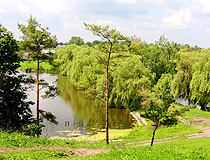
Nature of the Ternopil region
Author: Ruslan Daniluk
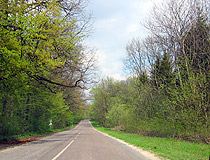
Paved road in Ternopil Oblast
Author: Ruslan Daniluk
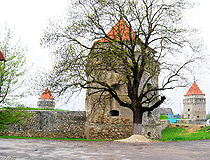
Skalat Castle in the Ternopil region
Author: Mykola Swarnyk
Ternopil Region - Features
Ternopil Oblast is located on the Podolian Upland. The southern border of the region passes along the Dniester River, the eastern border - along the Zbruch River. The length of the Ternopil region from north to south is 195 km, from west to east - 129 km. The climate is moderately continental with warm humid summers and mild winters. The average air temperature ranges from minus 5 degrees Celsius in January to plus 19 degrees Celsius in July.
There are significant reserves of building minerals (limestone, chalk, marl, gypsum, quartz sand, sandstone, brick-tiled clay, gravel-pebble materials), reserves of peat and small deposits of brown coal. Also there are significant reserves of mineral medicinal waters.
About 85% of the land of the region is used for agriculture. The percentage of arable land in the structure of agricultural land is 84%, which is one of the highest rates in Ukraine. The agricultural sector is the leading industry of Ternopil Oblast. Its share in the gross output of the region exceeds 60%. The agricultural sector produces about 3% of all-Ukrainian agricultural products, sugar and alcohol - more than 10%.
In the structure of industrial production of the Ternopil region, the food industry, engineering, and light industry have the largest share.
The tourism industry is a promising industry for development. About 2,000 square kilometers of landscape areas of the region (15% of the total area) are of recreational importance. There are over 400 territories and objects of the natural reserve fund, including the Medobory Natural Reserve, 308 nature monuments including 12 of state importance, 18 parks - monuments of landscape art, 4 of which are of state importance.
Ternopil Oblast hosts more than 25 different festivals. The most common type of decorative art - embroidery - has unique features in all areas of the region and differs in composition, technique, colors.
Attractions of Ternopil Oblast
The main tourist objects of the Ternopil region are the national natural parks “The Dniester Canyon” and “The Kremenetsky Mountains”, Kremenetsky-Pochayevsky historical and cultural reserve and the National reserve “The Castles of Ternopil Oblast”, the cities of Ternopil, Chortkiv, Berezhany, Buchach, Borshchiv, Terebovlya, the resorts of Husyatyn and Mykulyntsi.
Optymistychna (Optimistic) Cave, the longest karst cave in Europe (about 240 kilometers), is located on the territory of the Ternopil region, as well as the Dniester Canyon - one of the “Seven Natural Wonders of Ukraine”. The Dzhuryn (Chervonohrad) Waterfall located on the Dzhuryn River is the largest flat waterfall in Ukraine. By the number of castles (34), Ternopil Oblast is ranked first in Ukraine.
In the Ternopil region, there are 26 state museums and 140 public museum institutions including the Ternopil Regional Museum of Local Lore, the Ternopil Art Museum, the Borshchiv Museum of Local Lore, the Ethnographic-Memorial Museum of Vladimir Gnatyuk, the Les Kurbas Memorial Museum, and others.
On the territory of Ternopil Oblast there are 426 monuments of archeology (6 monuments of national importance), 1,673 monuments of history (1), 1,315 monuments of architecture and town planning (180), 164 monuments of monumental art.
The most interesting preserved monuments of history and culture:
- Vyshnivets: the Vyshnivets Palace and the park of the 18th century,
- Husyatyn: Onufrievskaya Church of the second half of the 16th century, the Bernardine church and monastery of the 16th-17th centuries, the town hall,
- Zalishchyky: the palace of the 18th century,
- Mezhyhirya: the Slavic cave church of the 10th-17th centuries with a sacrificial stone and the Ascension Church of the 17th century,
- Pidhaitsi: the Catholic church of the 15th-17th centuries, the Assumption Church of the 17th century, the synagogue of the 17th century,
- Pochaiv - Holy Dormition Pochaiv Lavra, an important spiritual center of Orthodoxy in Western Ukraine,
- Mykulyntsi: the castle of the 16th century, the palace of the 18th-19th centuries, the Catholic church of the 18th century,
- Kryvche: the castle of the 17th century,
- Sapohiv: the wooden church of the 18th century,
- Skala-Podilska: the castle of the 15th-16th centuries, the defensive tower of the 16th century, the baroque palace, the Catholic church, and the park of the 18th century,
- Skalat: the castle of 1630,
- Skoryky: the wooden church of John the Theologian of the 17th century,
- Yazlovets in the Buchach district: the ruins of the castle of the 14th-18th centuries, St. Nicholas Church of the 17th century, the Assumption Church (1589-1590), the palace of the middle of the 17th century.


